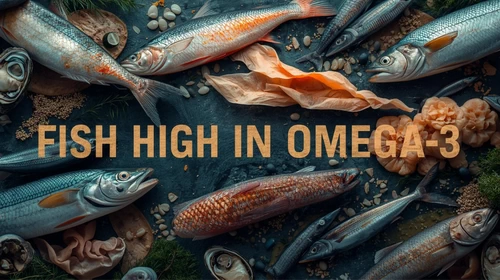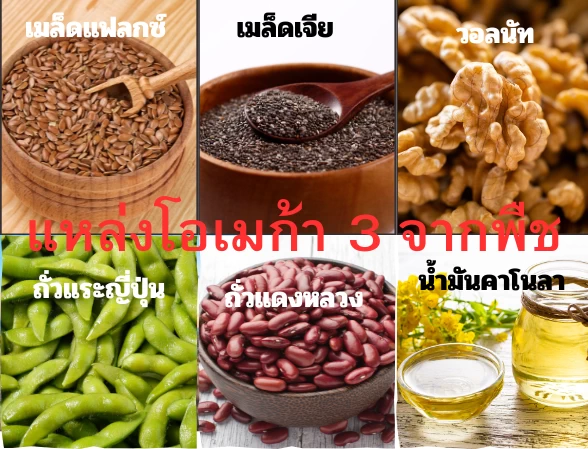
หน้าหลัก | สุขภาพดี | สุภาพสตรี | การแปลผลเลือด | โรคต่างๆ | ยารักษาโรค |วัคซีน | อาหารเพื่อสุขภาพ
12 สุดยอดอาหารโอเมก้า 3 สูง (Omega-3) ที่คุณต้องรู้! บำรุงสมองและหัวใจ
กรดไขมันโอเมก้า 3 (Omega-3) คือไขมันดีที่จำเป็นต่อร่างกายและสมองอย่างยิ่ง แต่ร่างกายไม่สามารถสร้างขึ้นเองได้ จึงต้องได้รับจากอาหารเท่านั้น องค์กรสุขภาพชั้นนำทั่วโลกแนะนำให้ผู้ใหญ่สุขภาพดีบริโภคโอเมก้า 3 อย่างน้อย 250–500 มิลลิกรัมต่อวัน เพื่อช่วยลดการอักเสบ บำรุงหัวใจและหลอดเลือด และส่งเสริมการทำงานของสมอง
บทความนี้ได้รวบรวม 12 สุดยอดอาหารจากธรรมชาติที่อุดมไปด้วยโอเมก้า 3 ทั้งจากแหล่งพืชและสัตว์ทะเล เพื่อให้คุณสามารถเลือกเสริมในมื้ออาหารของคุณได้อย่างง่ายดาย
โอเมก้า 3 คืออะไร? รู้จัก 3 ชนิดสำคัญ
ก่อนจะไปดูรายการอาหาร เรามาทำความรู้จักโอเมก้า 3 ทั้ง 3 ชนิดหลักกันก่อน:
-
ALA (Alpha-Linolenic Acid): พบมากในพืช เช่น เมล็ดแฟลกซ์ เมล็ดเจีย และวอลนัท ร่างกายต้องแปลง ALA เป็น EPA และ DHA ก่อนนำไปใช้ ซึ่งกระบวนการแปลงนี้มีประสิทธิภาพค่อนข้างจำกัด
-
EPA (Eicosapentaenoic Acid): มีบทบาทสำคัญในการลดการอักเสบในร่างกาย พบมากในปลาทะเลน้ำลึกและอาหารทะเล
-
DHA (Docosahexaenoic Acid): เป็นส่วนประกอบสำคัญของสมองและจอประสาทตา มีความจำเป็นอย่างยิ่งต่อพัฒนาการและการทำงานของสมอง พบมากในแหล่งเดียวกับ EPA
ดังนั้น การได้รับ EPA และ DHA จากอาหารโดยตรงจึงมีประสิทธิภาพต่อร่างกายมากที่สุด

สุดยอดอาหารแหล่งโอเมก้า 3 สูง
เราได้แบ่งรายการอาหารออกเป็น 2 กลุ่มหลัก คือแหล่งจากทะเล (อุดมด้วย EPA และ DHA) และแหล่งจากพืช (อุดมด้วย ALA)
กลุ่มที่ 1: แหล่งโอเมก้า 3 จากทะเล (EPA & DHA)
ปลาทะเลไขมันสูงคือแหล่งของ EPA และ DHA ที่ดีที่สุด
1. ปลาแมคเคอเรล (Mackerel) 🐟
-
ปริมาณโอเมก้า 3: ประมาณ 4,107 - 5,134 มก. ต่อ 100 กรัม
-
ปลาขนาดเล็กไขมันสูงที่อัดแน่นไปด้วยสารอาหาร นอกจากโอเมก้า 3 แล้ว ยังเป็นแหล่งวิตามิน B12 และซีลีเนียมชั้นเยี่ยม
2. ปลาแซลมอน (Salmon)
-
ปริมาณโอเมก้า 3: ประมาณ 2,260 มก. ต่อ 100 กรัม (สำหรับแซลมอนแอตแลนติก)
-
ราชาแห่งปลาที่มีประโยชน์รอบด้าน อุดมด้วยโปรตีนคุณภาพสูง วิตามินดี และซีลีเนียม การทานแซลมอนเป็นประจำสัมพันธ์กับความเสี่ยงที่ลดลงของโรคหัวใจ ภาวะสมองเสื่อม และซึมเศร้า
3. น้ำมันตับปลา (Cod Liver Oil)
-
ปริมาณโอเมก้า 3: ประมาณ 2,682 มก. ต่อ 1 ช้อนโต๊ะ
-
แม้จะเป็นอาหารเสริมมากกว่าอาหาร แต่ก็เป็นแหล่งโอเมก้า 3 เข้มข้น ทั้งยังอุดมไปด้วยวิตามิน D และ A อย่างไรก็ตาม ไม่ควรทานเกิน 1 ช้อนโต๊ะต่อวัน เพราะการได้รับวิตามิน A มากเกินไปอาจเป็นอันตรายได้
4. ปลาเฮอร์ริ่ง (Herring)
-
ปริมาณโอเมก้า 3: ประมาณ 2,366 มก. ต่อ 100 กรัม
-
ปลาทะเลไขมันสูงที่นิยมนำมารมควันหรือดอง เป็นแหล่งวิตามิน D, B12 และซีลีเนียมที่ดีเยี่ยม
5. หอยนางรม (Oysters)
-
ปริมาณโอเมก้า 3: ประมาณ 435 มก. ต่อ 100 กรัม (มีทั้ง ALA, EPA, DHA)
-
เป็นอาหารทะเลที่โดดเด่นเรื่องแร่ธาตุสังกะสี (Zinc) สูงที่สุดในบรรดาอาหารทั้งหมด ทั้งยังเป็นแหล่งของทองแดงและวิตามิน B12 ที่ดีอีกด้วย
6. ปลาซาร์ดีน (Sardines)
-
ปริมาณโอเมก้า 3: ประมาณ 1,480 มก. ต่อ 100 กรัม
-
ปลาตัวเล็กแต่มหัศจรรย์ทางโภชนาการ โดยเฉพาะเมื่อทานทั้งตัว จะได้รับสารอาหารแทบทุกชนิดที่ร่างกายต้องการ รวมถึงแคลเซียมจากกระดูกปลา

กลุ่มที่ 2: แหล่งโอเมก้า 3 จากพืช (ALA)
สำหรับผู้ทานมังสวิรัติหรือต้องการแหล่งโอเมก้า 3 เพิ่มเติม พืชเหล่านี้คือคำตอบ
7. เมล็ดแฟลกซ์ (Flax Seeds) 🌱
-
ปริมาณโอเมก้า 3: ประมาณ 2,350 มก. ต่อ 1 ช้อนโต๊ะ (แบบเมล็ด) หรือ 7,260 มก. ต่อ 1 ช้อนโต๊ะ (แบบน้ำมัน)
-
นี่คือราชาแห่งโอเมก้า 3 ชนิด ALA จากพืช นอกจากนี้ยังอุดมไปด้วยไฟเบอร์ แมกนีเซียม และมีสัดส่วนโอเมก้า 6 ต่อโอเมก้า 3 ที่ดีเยี่ยม
8. เมล็ดเจีย (Chia Seeds)
-
ปริมาณโอเมก้า 3: ประมาณ 5,060 มก. ต่อ 28 กรัม (ประมาณ 2 ช้อนโต๊ะ)
-
เมล็ดพืชสารพัดประโยชน์ที่เต็มไปด้วยไฟเบอร์ โปรตีน แมงกานีส และแมกนีเซียม เหมาะสำหรับใส่ในสมูทตี้ โยเกิร์ต หรือทำพุดดิ้ง
9. วอลนัท (Walnuts)
-
ปริมาณโอเมก้า 3: ประมาณ 2,570 มก. ต่อ 28 กรัม (ประมาณ 14 ซีก)
-
ถั่วเพียงชนิดเดียวที่มีปริมาณ ALA สูงอย่างมีนัยสำคัญ ทั้งยังอุดมด้วยสารต้านอนุมูลอิสระ โดยเฉพาะบริเวณเปลือกบางๆ ที่หุ้มเนื้ออยู่
10. ถั่วแระญี่ปุ่น / ถั่วเหลือง (Edamame / Soybeans)
-
ปริมาณโอเมก้า 3: ประมาณ 1,443 มก. ต่อ 100 กรัม (สำหรับถั่วเหลืองคั่วแห้ง)
-
เป็นแหล่งโปรตีนจากพืชชั้นดี และให้สารอาหารอื่นๆ เช่น โฟเลต วิตามินเค และโพแทสเซียม
11. น้ำมันคาโนลา (Canola Oil)
-
ปริมาณโอเมก้า 3: ประมาณ 1,279 มก. ต่อ 1 ช้อนโต๊ะ
-
เป็นน้ำมันพืชที่มีสัดส่วนโอเมก้า 3 ต่อโอเมก้า 6 ที่สมดุล เหมาะสำหรับใช้ปรุงอาหารที่ไม่ใช้ความร้อนสูง เช่น ทำน้ำสลัด
12. ถั่วแดงหลวง (Kidney Beans)
-
ปริมาณโอเมก้า 3: ประมาณ 100 มก. ต่อ 1/2 ถ้วย (ปรุงสุก)
-
แม้จะมีปริมาณไม่สูงเท่าแหล่งอื่นๆ แต่ก็เป็นทางเลือกที่ดีในการเพิ่มโอเมก้า 3 สำหรับผู้ที่ทานพืชเป็นหลัก
https://www.medicalnewstoday.com/articles/323144#vegetarian-and-vegan-sources-of-omega-3
https://www.myfooddata.com/articles/high-omega-3-foods
